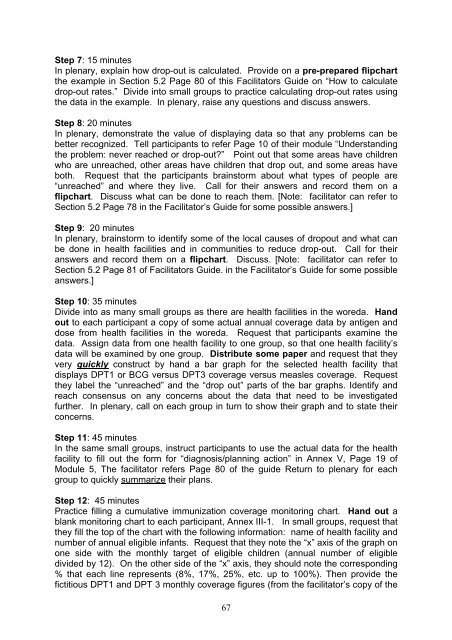Refresher Training for Frontline Health Workers in Expanded ... - RHO
Refresher Training for Frontline Health Workers in Expanded ... - RHO
Refresher Training for Frontline Health Workers in Expanded ... - RHO
You also want an ePaper? Increase the reach of your titles
YUMPU automatically turns print PDFs into web optimized ePapers that Google loves.
Step 7: 15 m<strong>in</strong>utes<br />
In plenary, expla<strong>in</strong> how drop-out is calculated. Provide on a pre-prepared flipchart<br />
the example <strong>in</strong> Section 5.2 Page 80 of this Facilitators Guide on “How to calculate<br />
drop-out rates.” Divide <strong>in</strong>to small groups to practice calculat<strong>in</strong>g drop-out rates us<strong>in</strong>g<br />
the data <strong>in</strong> the example. In plenary, raise any questions and discuss answers.<br />
Step 8: 20 m<strong>in</strong>utes<br />
In plenary, demonstrate the value of display<strong>in</strong>g data so that any problems can be<br />
better recognized. Tell participants to refer Page 10 of their module “Understand<strong>in</strong>g<br />
the problem: never reached or drop-out?” Po<strong>in</strong>t out that some areas have children<br />
who are unreached, other areas have children that drop out, and some areas have<br />
both. Request that the participants bra<strong>in</strong>storm about what types of people are<br />
“unreached” and where they live. Call <strong>for</strong> their answers and record them on a<br />
flipchart. Discuss what can be done to reach them. [Note: facilitator can refer to<br />
Section 5.2 Page 78 <strong>in</strong> the Facilitator’s Guide <strong>for</strong> some possible answers.]<br />
Step 9: 20 m<strong>in</strong>utes<br />
In plenary, bra<strong>in</strong>storm to identify some of the local causes of dropout and what can<br />
be done <strong>in</strong> health facilities and <strong>in</strong> communities to reduce drop-out. Call <strong>for</strong> their<br />
answers and record them on a flipchart. Discuss. [Note: facilitator can refer to<br />
Section 5.2 Page 81 of Facilitators Guide. <strong>in</strong> the Facilitator’s Guide <strong>for</strong> some possible<br />
answers.]<br />
Step 10: 35 m<strong>in</strong>utes<br />
Divide <strong>in</strong>to as many small groups as there are health facilities <strong>in</strong> the woreda. Hand<br />
out to each participant a copy of some actual annual coverage data by antigen and<br />
dose from health facilities <strong>in</strong> the woreda. Request that participants exam<strong>in</strong>e the<br />
data. Assign data from one health facility to one group, so that one health facility’s<br />
data will be exam<strong>in</strong>ed by one group. Distribute some paper and request that they<br />
very quickly construct by hand a bar graph <strong>for</strong> the selected health facility that<br />
displays DPT1 or BCG versus DPT3 coverage versus measles coverage. Request<br />
they label the “unreached” and the “drop out” parts of the bar graphs. Identify and<br />
reach consensus on any concerns about the data that need to be <strong>in</strong>vestigated<br />
further. In plenary, call on each group <strong>in</strong> turn to show their graph and to state their<br />
concerns.<br />
Step 11: 45 m<strong>in</strong>utes<br />
In the same small groups, <strong>in</strong>struct participants to use the actual data <strong>for</strong> the health<br />
facility to fill out the <strong>for</strong>m <strong>for</strong> “diagnosis/plann<strong>in</strong>g action” <strong>in</strong> Annex V, Page 19 of<br />
Module 5, The facilitator refers Page 80 of the guide Return to plenary <strong>for</strong> each<br />
group to quickly summarize their plans.<br />
Step 12: 45 m<strong>in</strong>utes<br />
Practice fill<strong>in</strong>g a cumulative immunization coverage monitor<strong>in</strong>g chart. Hand out a<br />
blank monitor<strong>in</strong>g chart to each participant, Annex III-1. In small groups, request that<br />
they fill the top of the chart with the follow<strong>in</strong>g <strong>in</strong><strong>for</strong>mation: name of health facility and<br />
number of annual eligible <strong>in</strong>fants. Request that they note the “x” axis of the graph on<br />
one side with the monthly target of eligible children (annual number of eligible<br />
divided by 12). On the other side of the “x” axis, they should note the correspond<strong>in</strong>g<br />
% that each l<strong>in</strong>e represents (8%, 17%, 25%, etc. up to 100%). Then provide the<br />
fictitious DPT1 and DPT 3 monthly coverage figures (from the facilitator’s copy of the<br />
67
















